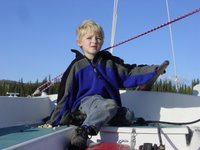
The ship at sea is a strict classroom, but one with few distractions. Since the dawn of seafaring, children have been going to sea, learning to shoulder responsibility and to act as men and women at a young age.
As master of a dinghy or as Junior Officer on the quarterdeck, a young boy or girl can try out the boots of command without tossing over their childhood shoes. Plenty of room to make mistakes, room to shine, to compete, but it's not bumper cars. The sense of responsibility is tangible. There are rules. There is just enough danger, and real at that. There is tradition to live up to.
A recent adventure comes to mind. I was lake sailing last summer with my ten year old son Blayde in our 11 foot mirror dinghy. The wind was twelve to seventeen knots with occasional higher puffs. The shallow, warm lake had built a small chop of about a foot or so. My lifetime friend Raoul and his family were on the Laura Ann II, our Venture 24, as were my wife and other two boys. They were having a great sail, casually racing the other boats out on that blustery day.
The mirror was sailing hard, taking an occasional wave top over the rail. Blayde was at the helm, and I was keeping the bilge empty and providing ballast. Blayde sensed that the boat was near her limits (for his skill) and he voiced his concern, but knowing that even if we capsized we would be in no danger, I told him that we should catch the Laura Ann II to find respite. I did not know at the time that he took this to mean that our lives depended on it.
With renewed resolution he pressed on, taking every advantage to close the gap to the much faster 24 foot sloop. Laura Ann II darted this way and that in pursuit of other boats to show her heels. With each change in direction, Blayde cut the distance, pressing the little dinghy for every ounce of speed she could muster. With grim resolve, Blayde relentlessly sailed ever harder, and in and hour or so the gap was closed within a ropes throw.
The Laura Ann II, luffing to slow for us tossed a line. I took the helm of the dinghy and told Blayde to make it fast to our bow cleat. Though the larger sloop was doing her best -short of taking down sail- to accommodate us, the wind veered a bit and she picked up speed. The end of the line was pulling hard, and Blayde could not get enough to take a turn on the cleat. Not understanding his frame of mind, I wondered at why he kept trying, even beyond his strength, to pull us up to the skittish Laura Ann II. After fierce effort, he lost the end of the line. When he looked over his shoulder to me, I then understood that he felt that his failure had secured our doom.
Suddenly feeling cruel and foolish, I reassured him that all was well, and we would make another pass. Raoul brought the sloop around, and as she passed us we secured to her hip. Still showing no signs of weakness, Blayde climbed aboard the twenty four foot sloop into a world of relative calm. Taking his leave formally, he went below and broke down for a few minutes, having escaped, in his young eyes, a brush with death.
In retrospect, contrasting what he must have been feeling with his actions, I cannot help but beam with pride over his great courage and resolve. Though he thought we were in mortal danger, his determination never faltered. He bravely pressed on, well beyond his comfort, in order to “save” us. In my ignorance, I was having a grand time, casually sponging the splashes out and enjoying my turn at being rail meat. Meanwhile, he thought that my efforts were all that were keeping us afloat, and that he must persevere at the helm to secure our safety.
Since that time, he has learned a great deal, and can now sail the Venture 24 in mild conditions on his own. He says that if his little brothers could be trained a little better, that they could go anywhere. I’m not quite sure about that, but I am sure that he grew that day, and that he learned one of many lessons to come - from wind and wave.



1 Comments:
His strenght comes directly from the example of his father....
Post a Comment
<< Home